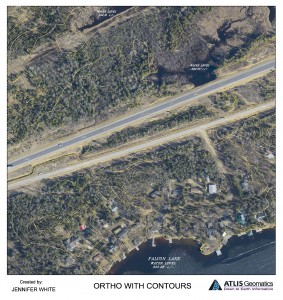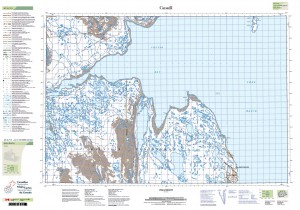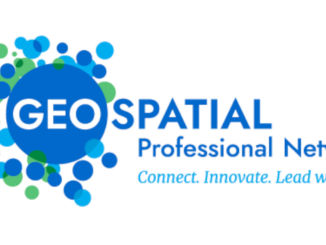
GoGeomatics met with Jenn White a photogrammetry and cartographic specialist to talk about her job hunt and her career. Jenn has worked has worked for the federal government in Ottawa and for industry in the prairies.
GoGeomatics: Where are you from?
Jenn: I’m from the extremely hot and extremely cold city of Winnipeg, Manitoba. I moved to Ottawa when The Centre for Topographic Information at Natural Resources Canada offered me a term to work with them. I jumped at the opportunity and was excited to live in a new city.
GoGeomatics:Where did you go to school?

Jenn: I attended the University of Manitoba. I did my B.A. Advanced with my Major in Geography. In my second year of studies, I took a cartography course and it was from that course, I became passionate about working with and creating maps.
In my mind, cartography is a perfect blend of art and science. It’s artistic because the map is the canvas and you’re depicting the real world in colours, lines and symbols. You get to be creative in how to represent the real-world. On the other hand, there’s also the science to it. Maps must be to scale. Measurements must be accurate. For a topographic map, the contours must give an accurate representation of the terrain. You can’t delete a contour just because it’s cramped between the shoreline and the adjacent contour. It’s your responsibility to give the contour a “good fit”. A Cartographer has to adhere to the rules of cartography and also to the mapping specifications that are set out by their company.
For example, you want to be consistent in where you place the text that informs the map-reader of the geographic location of the mapping area. When you work on adjoining maps, you want the sheets to be similar in where the geographic location text is situated. Then the map reader’s eyes will always be drawn to the same spot to find the information.
That being said, cartography was taking second place to GIS. At that time, GIS was all the rage and was seen as the way of the future. I knew from back then that I would have to build a career in GIS so I could still have the opportunity to create maps.
GoGeomatics: How much GIS were you exposed to at university?
Jenn: This is really going back. There was one course that introduced and explained the concepts of GIS. However, there wasn’t any GIS software that we could use in the labs. The department was planning on purchasing GIS software in the, then, near future. The professors and instructors strongly encouraged us to take the initiative to learn about GIS on our own. It wasn’t until I got into the work force that I was exposed to GIS.
GoGeomatics: Can you give me the highlights of your working life so far?
Jenn: My most recent highlight would be working for Natural Resources Canada in mapping Canada’s North. I was one of many who created 1:50,000 National Topographic Sheets. This was the first time in Canada’s history where the entire Northern part of Canada has been mapped. Being part of history in the making is quite exciting.
In 2009, for my thesis project, I worked with Manitoba Hydro on creating raster images of temperature and precipitation scenarios over their water basins. I used tabular data from Global Climate Models (Canadian Centre for Climate Modelling and Analysis) and created raster images. The next step was to create an animation from all the raster images to illustrate the changing patterns.
GoGeomatics: Before that you were with ATLIS can you tell us a little about that?
Jenn: I accumulated my photogrammetry knowledge during my time at ATLIS. I’m quite proud of myself for being able to create Digital Elevation Models (DEM) in stereo. Not everyone can see objects in 3D. Furthermore, being able to work in stereo takes time to learn and master.
 Creating DEMs involves looking at overlapping aerial photos in 3D. I wore special glasses that would enable me to see the aerial photos. I would capture elevation points and breaklines to form the DEM. Some people use hand wheels, a foot wheel and pedals for doing data capture, but I used a hand puck. For me, using a hand puck was more comfortable rather than having to turn wheels and use my foot to click and capture points. The elevation points would be captured in a grid. Then additional points and breaklines would be added in order to represent the terrain features. An area with lots of relief would need a denser grid with lots of breaklines and additional elevation points. However, an area of flat terrain could have a larger grid with fewer breaklines.
Creating DEMs involves looking at overlapping aerial photos in 3D. I wore special glasses that would enable me to see the aerial photos. I would capture elevation points and breaklines to form the DEM. Some people use hand wheels, a foot wheel and pedals for doing data capture, but I used a hand puck. For me, using a hand puck was more comfortable rather than having to turn wheels and use my foot to click and capture points. The elevation points would be captured in a grid. Then additional points and breaklines would be added in order to represent the terrain features. An area with lots of relief would need a denser grid with lots of breaklines and additional elevation points. However, an area of flat terrain could have a larger grid with fewer breaklines.
The DEMs could then be used to orthorectify the aerial photos. Orthorectification involves altering the aerial photos so accurate distance measurements can be taken. Moreover, the orthophotos are now geo-referenced. Mosaics could be created from all the orthophotos.
The DEMs could also be used to create contour maps. Many of ATLIS’ clients would purchase orthophotos and overlay the contours on their maps. ATLIS uses KLT software which is a suite package. ATLAS/DSP (Digital Stereoplotting) was the program geared to DEM capture. ATLAS/Ortho was used to rectify the orthophotos. Finally, ATLAS was the program used for map editing.
It was always fun for me to do DEM updates on cities. I could see where development had taken place since the DEM no longer matched the photos. This usually happened with urban expansion and road construction.
A great difference was made in DEM capture when the company moved from film imagery to digital imagery. The resolution increased vastly and it made data capture much easier.
GoGeomatics: How did your job change during your time at ATLIS? You were there for a number of years.
Jenn: It wasn’t my job that changed, it was me who changed. There are so many branches to Geomatics. I had reached that point where I was eager to learn more and I wanted to broaden my skills.
GoGeomatics: It was after that job that you went to Red River College. Can you tell us about the program they have for GIS? For you what were the highlights?
Jenn: To begin, Red River College is situated in one of the city’s industrial areas. It’s a technical college with a small campus surrounded with lots of green space. The green space is nice to wander around for fresh air during the nice weather. All the buildings on the campus are connected by hallways so you don’t have to go outside into the bitter cold during the winter.
The Geographic Information Systems Technology course itself is an intense but rewarding course. It’s a one year course and that tries to cover all the bases to prepare you for the GIS industry.
GoGeomatics: How large is the GIS program at Red River College?
Jenn: When I attended, we spent the day in a lab and the instructors would come in and teach their respective courses. The lab can accommodate 12 people. There were only 9 students when I was enrolled.
The courses offered are: cartography, programming, remote sensing, CAD, geodatabase management, surveying, spatial statistics and project management.
GoGeomatics: Did you have to write a final thesis?
Jenn: In the last two terms of the program, students have to work on a thesis project. Companies who work with GIS will offer projects to the students. That was how I got to work with Manitoba Hydro.
GoGeomatics: Can you tell us about what the instructors are like?
Jenn: In regards to the instructors: one instructor is Mr. Roger Hamelin and he has been teaching there for years. He teaches programming, surveying and project management. He was always available to help students when help was needed. When it came to upcoming jobs opportunities, he was one of the instructors who would tell us who was hiring or might be hiring.
GoGeomatics: Highlights of the program?
Jenn: As for saying what the highlight of the course was for me, I honestly have to say that it was the sheer excitement of being there and learning. Looking back, I tried to soak up everything that I could. Each project that I completed gave me the thrill of knowing that I had acquired more knowledge and skills. Plus, there were always maps to submit as part of the project.
GoGeomatics: You’re currently on the job hunt now. How’s it going?
Jenn: I am currently looking for my next opportunity. It’s been challenging for me since I’m new to the city and I have to learn who the companies that deal with GIS are. So not only am I doing the job search in the classical sense of doing internet searches, I also have to go out and meet other people who work in GIS as well.
GoGeomatics: Other than the GoGeomatics job board where do you look for jobs?
Jenn: I’ve met with MaxSys Consulting and Staffing and ATLIS HR. I also use Peter’s New Jobs and the Government of Canada job website.
GoGeomatics: Have you had any interviews?
Jenn: I have had some interviews and I’ve met some really great people. Having those interviews has also allowed me to learn more about the companies in regards to their projects and how the company itself functions.
GoGeomatics: Can you tell us about your most recent interviews? How did it go? What was the job?
Jenn: My most recent interview was for an environmental company. I felt that it went well. The job was for a GIS Technologist. The company would like to expand their Geomatics sector.
The one before that was with the Government of Canada for an upcoming project. It was more of an informal meeting so the manager could get a better idea of who I am. Any interview is good practice for the next one.
GoGeomatics: What place do you feel networking has for job hunting? Do you try to network? If so how?
Jenn: Networking is helpful to meet people who are either in, or who know someone who are in the industry. It allows you to hear about the work that other people do. It can help determine which companies you want to work for. Plus, networking gives you a chance to “put a face to the resume”. Personality isn’t something that is reflected on a resume. By meeting with people, they gain a better idea of who you are and vice versa.
I’ve gone to GIS user groups such as the CanadianGIS user group, the National Capital Region GIS users group. I plan to go to the OSGeo group as well.
GoGeomatics: Do you have any skill areas that you want to expand? New tools you might be interested in learning?
Jenn: I’ve always worked in an office so I’d like to learn more about surveying and acquire field experience.
I’m currently trying out ArcView 10. Plus I’m reading about Open geospatial data and its software.
As well I’m slowly working my way through the OSGeo website.
GoGeomatics: Where do you think your strengths lay in geomatics? A particular discipline?
Jenn: My strengths are in and photogrammetry. It always seems like the projects end with a final map which is great for me because I enjoy making maps.
GoGeomatics: What would be your dream job? Where? Doing what?
Jenn: My dream job would be where I could work on projects from start to finish. I would like to go out in the field and collect data. Then take that data, compile any other necessary information and work on the project(s). It would be great to continue working with photogrammetry and produce some maps as final deliverables.
I’d be happy with a company where I feel useful and I know that I’m contributing to that company’s success.
GoGeomatics: Thanks for taking the time to talk with us an share your experiences in the Geomatics industry. Any advice for other job seekers out there?
Jenn: Be patient but be assertive.
IF you wanted to contact Jenn you can reach here on email here [email protected]





Be the first to comment